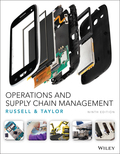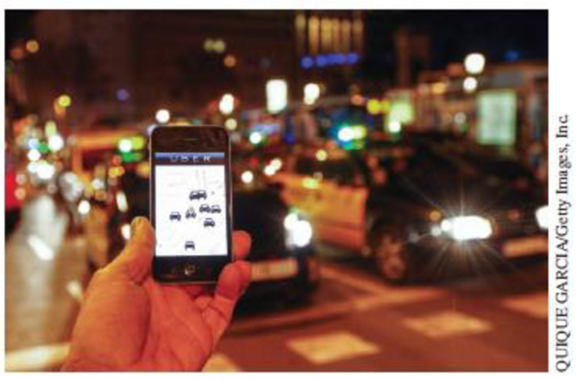
Concept explainers
Uber and the Sharing Economy
First there was Zipcar and BikeShare, where customers could conveniently rent a vehicle or bike near their home or place of work; then came Airbnb, Uber, and Snapgoods, where ordinary people could use their assets (homes, cars, household goods) to bring in extra cash. Now a full-blown sharing economy exists that supplies income to providers and new functionality to users (e.g., Dogvacy, TaskRabbit, Getaround, Lyft, LendingClub, Fon, and Turo).
Take Uber, for example, with its easy-to-use apps, quick service, and aff ordable prices. Uber acts as a broker, connecting people who need rides with people who can provide them. Add cool cars (UberBLACK and UberLUX), larger vehicles (UberSUV and UberHAUL), ride sharing (UberPOOL), and new modes of transportation (UberTAXI and UberCOPTER). Look for new logistical opportunities to deliver packages (UberRUSH), groceries (UberFRESH), and restaurant meals (UberEATS). Use Uber data to recommend services or activities, send messages or predict behavior, and when technology allows, send out an autonomous vehicle coordinated to a customer’s daily
Innovations such as shared services are transforming industries. It may seem simple for a company like Uber to establish an online marketplace where providers and customers match needs, but it can actually be quite complex. Companies that run this type of business are data- and technology-driven, and they are constantly looking for ways to use data to improve their services or gain a competitive edge. Operating in 330 cities and 59 countries, Uber’s one million active drivers transport millions of customers each day. Uber maintains a vast database on its drivers, wherever they are located, so that passengers can be matched quickly with available drivers. Data about passenger preferences is collected, too, for future use. And both the driver and the passenger can submit reviews of the service encounter.
Fares are calculated automatically, using GPS, street data and, of course, Uber’s own algorithms that make adjustments based on trip time (because time, not distance, drives fares) and other factors. “Surge pricing” kicks in during busy or difficult times to incentivize drivers to become active. Sometimes the results are extreme, as when one passenger paid $137 a mile on New Year’s Eve in New York City, or when a Washington, DC, passenger paid $640 for a $50 trip during a snowstorm. New York City has since negotiated a cap on surge pricing during inclement weather at 3.5 times the normal rate. In the meantime, Uber has applied for a patent on its special surge-pricing model.

How far do you think the shared economy can go? Give examples of services that you would be willing to use or host peer-to-peer. What new shared services are on the horizon?
To explain: How far can the shared economy go, with examples. What are the new shared services on the horizon?
Explanation of Solution
Examples of how fare the shared economy can go and new shared services on the horizon:
The future of the shared economy is only limited by one’s imagination. Some of the possibilities are:
Shared electricity – households and offices getting their energy requirements from different sources such as solar panels and wind turbines. Therefore, not being completely reliant on the power grid.
Shared digital storage – companies and individuals are already moving from storing data locally to storage on a cloud server. The trend is growing exponentially.
Shared physical storage – online services have allowed individuals to rent out storage space in their apartments, when they are on holiday or have excess space. Thereby monetizing the unused space in homes.
Want to see more full solutions like this?
Chapter 5 Solutions
Operations and Supply Chain Management 9th edition
Additional Business Textbook Solutions
Gitman: Principl Manageri Finance_15 (15th Edition) (What's New in Finance)
Principles of Economics (MindTap Course List)
Financial Accounting, Student Value Edition (5th Edition)
Operations Management: Processes and Supply Chains (12th Edition) (What's New in Operations Management)
Operations Management
MARKETING:REAL PEOPLE,REAL CHOICES
- Cariveh Co sells automotive supplies from 25 different locations in one country. Each branch has up to 30 staff working there, although most of the accounting systems are designed and implemented from the company's head office. All accounting systems, apart from petty cash, are computerised, with the internal audit department frequently advising and implementing controls within those systems. Cariveh has an internal audit department of six staff, all of whom have been employed at Cariveh for a minimum of five years and some for as long as 15 years. In the past, the chief internal auditor appoints staff within the internal audit department, although the chief executive officer (CEO) is responsible for appointing the chief internal auditor. The chief internal auditor reports directly to the finance director. The finance director also assists the chief internal auditor in deciding on the scope of work of the internal audit department. You are an audit manager in the internal audit…arrow_forwardPlease show all steps and answers, thank you!arrow_forwardI am not sure if this is correct, because 8 cannot go directly to 10.arrow_forward
- A practical application in real life to the Critical Path Method is the construction of a bridge with references, give a detailed essay on the stages involved in constructing a bridgearrow_forwardPlease assist in writing a complete reasearch project of the following title: Title of research: Study on the impact of Technology in the Work Place.arrow_forwardIntuition is both an emotional experience and a nonconscious analytic process. One problem, however, is that not all emotions signaling that there is a problem or opportunity represent intuition. Please in your Personal opinion how we would know if our “gut feelings” are intuition or not, and if not intuition, suggest what might be causing them.arrow_forward
- A coworker suggests that the company where you both work would be much more effective if there were no organizational politics. Please in your personal and detailed opinion, What would you say to this person in reply?arrow_forwardWhat is a bottleneck? Would you try to reduce a bottleneck? Why or why not? Please provide a referencearrow_forwardYour firm has been the auditor of Caribild Products, a listed company, for a number of years. The engagement partner has asked you to describe the matters you would consider when planning the audit for the year ended 31January 2022. During recent visit to the company you obtained the following information: (a) The management accounts for the 10 months to 30 November 2021 show a revenue of $260 million and profit before tax of $8 million. Assume sales and profits accrue evenly throughout the year. In the year ended 31 January 2021 Caribild Products had sales of $220 million and profit before tax of $16 million. (b) The company installed a new computerised inventory control system which has operated from 1 June 2021. As the inventory control system records inventory movements and current inventory quantities, the company is proposing: (i) To use the inventory quantities on the computer to value the inventory at the year-end (ii) Not to carry out an inventory count at the year-end (c)…arrow_forward
- Develop and implement a complex and scientific project for an organisation of your choice. please include report include the following: Introduction Background research to the project The 5 basic phases in the project management process Project Initiation Project Planning Project Execution Project Monitoring and Controlling Project Closing Conclusionarrow_forwardNot use ai pleasearrow_forwardSam's Pet Hotel operates 51 weeks per year, 6 days per week, and uses a continuous review inventory system. It purchases kitty litter for $11.00 per bag. The following information is available about these bags: > Demand 95 bags/week > Order cost $52.00/order > Annual holding cost = 25 percent of cost > Desired cycle-service level = 80 percent >Lead time 4 weeks (24 working days) > Standard deviation of weekly demand = 15 bags > Current on-hand inventory is 320 bags, with no open orders or backorders. a. Suppose that the weekly demand forecast of 95 bags is incorrect and actual demand averages only 75 bags per week. How much higher will total costs be, owing to the distorted EOQ caused by this forecast error? The costs will be $ higher owing to the error in EOQ. (Enter your response rounded to two decimal places.)arrow_forward
- MarketingMarketingISBN:9780357033791Author:Pride, William MPublisher:South Western Educational Publishing
 Practical Management ScienceOperations ManagementISBN:9781337406659Author:WINSTON, Wayne L.Publisher:Cengage,
Practical Management ScienceOperations ManagementISBN:9781337406659Author:WINSTON, Wayne L.Publisher:Cengage,


